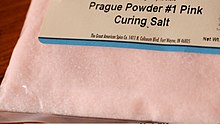
Curing salt is used in meat processing to generate a pinkish shade and to extend shelf life.[1] It is both a color agent and a means to facilitate food preservation as it prevents or slows spoilage by bacteria or fungus. Curing salts are generally a mixture of sodium chloride (table salt) and sodium nitrite, and are used for pickling meats as part of the process to make sausage or cured meat such as ham, bacon, pastrami, corned beef, etc. Though it has been suggested that the reason for using nitrite-containing curing salt is to prevent botulism, a 2018 study by the British Meat Producers Association determined that legally permitted levels of nitrite have no effect on the growth of the Clostridium botulinum bacteria that causes botulism, in line with the UK's Advisory Committee on the Microbiological Safety of Food opinion that nitrites are not required to prevent C. botulinum growth and extend shelf life.[2] (see also Sodium Nitrite: Inhibition of microbial growth).
Many curing salts also contain red dye that makes them pink to prevent them from being confused with common table salt.[3] Thus curing salt is sometimes referred to as "pink salt". Curing salts are not to be confused with Himalayan pink salt, a halite which is 97–99% sodium chloride (table salt) with trace elements that give it a pink color.
- ^ Sárraga, C.; Gil, M.; Arnau, J.; Monfort, J. M.; Cussó, R. (1989). "Effect of curing salt and phosphate on the activity of porcine muscle proteases". Meat Science. 25 (4). Elsevier Science: 241–249. doi:10.1016/0309-1740(89)90042-9. PMID 22054673.
- ^ Doward, Jamie (2019-03-23). "Revealed: no need to add cancer-risk nitrites to ham". The Observer. London. Archived from the original on 2021-01-26. Retrieved 2021-02-14.
The results show that there is no change in levels of inoculated C botulinum over the curing process, which implies that the action of nitrite during curing is not toxic to C botulinum spores at levels of 150ppm [parts per million] ingoing nitrite and below.
- ^ Bitterman, M. (2010). "Salt Reference Guide". Salted: A Manifesto on the World's Most Essential Mineral, with Recipes. Random House. p. 187. ISBN 978-1580082624. Retrieved 2013-08-16.